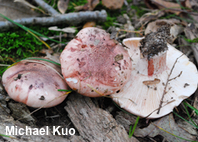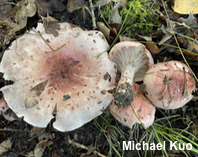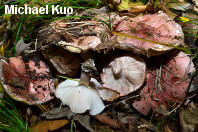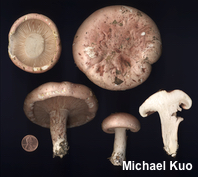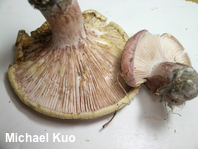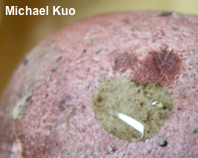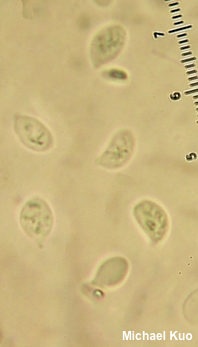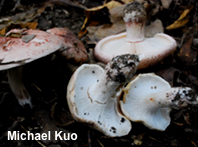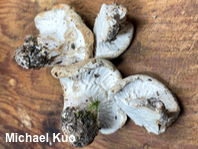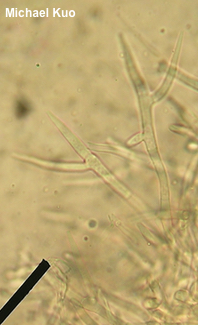| Major Groups > Gilled Mushrooms > Pale-Spored > Waxy Caps > Hygrophorus russula |

|
[ Basidiomycota > Agaricales > Hygrophoraceae > Hygrophorus . . . ] Hygrophorus russula by Michael Kuo, 22 September 2023 Before you inspect it closely, Hygrophorus russula certainly does look like a russula. In fact, when I first found this species, 20 years ago, I began my journal entry with the words "very curious pink russulas." But by the time I was describing the flesh as "firm and white throughout," my mushroom beginner's instincts were twitching: "I'm beginning to doubt these are russulas." The flesh of Hygrophorus russula is not at all crumbly and brittle like the flesh in russulas—but the species looks a lot more like a russula than a waxy cap, which is what it is. Two of the defining features of waxy caps are sticky caps and thick, waxy gills; Hygrophorus russula does have a sticky cap, but it soon dries out—and the gills are only arguably "thick and waxy." Features defining Hygrophorus russula include its russula-like stature, the reddish spotting on the mature gills, its association with hardwoods, and the fact that the cap and stem often feature streaks and spots of purplish pink shades. Several conifer-loving Hygrophorus species are very close in appearance, including Hygrophorus erubescens, with distant or nearly distant gills, and more pronounced yellow bruising; Hygrophorus amarus, with a bitter taste and pale greenish yellow immature gills; and Hygrophorus purpurascens, which has a partial veil when young. I regularly find Hygrophorus russula being parasitized by a mycotrophic fungus—possibly the asexual, anamorphic stage of a Hypomyces species. The parasite is whitish, and forms a layer of tissue over the gills and upper stem of the Hygrophorus; see the illustrations to the right. Description: Ecology: Mycorrhizal with oaks and other hardwoods; growing scattered or gregariously, sometimes in fairy rings or arcs; late summer and fall (also over winter in warmer climates); originally described from Bavaria (Schaeffer 1774); widespread in Europe and North America. The illustrated and described collections are from Illinois and Kentucky. Cap: 4–13 cm; convex when young, becoming broadly convex, flat, or shallowly depressed; sticky when fresh, but often drying out quickly; bald, or finely hairy in places; the margin at first inrolled and soft or cottony, but eventually unrolling; reddish to pinkish, often with streaks or spots of color, or with the pigment breaking up into a mosaic-like pattern; often bruising yellow in places, especially near the margin. Gills: Broadly attached to the stem or beginning to run down it; close or nearly distant; short-gills present but sometimes not numerous; creamy white when young, but soon developing reddish spots or becoming pinkish overall; sometimes yellowing in age. Stem: 3–7 cm long; 1–2 cm thick; more or less equal; white at first but soon developing the colors of the cap; bald or finely hairy; solid. Flesh: White, or flushed with pink; thick; firm. Odor and Taste: Not distinctive. Chemical Reactions: KOH on cap surface grayish to olive, erasing pink. Spore Print: White. Microscopic Features: Spores 7–9 x 3.–5 µm; ellipsoid; smooth; hyaline in KOH; inamyloid. Basidia to about 50 µm long; subclavate; 4-sterigmate. Cystidia not found. Lamellar trama divergent. Pileipellis an ixotrichoderm. REFERENCES: (J. C. Schaeffer, 1774) C. H. Kauffman, 1918. (Fries, 1821; Hesler & Smith, 1963; Bird & Grund, 1979; Smith, Smith & Weber, 1979; Largent, 1985; Arora, 1986; Breitenbach & Kränzlin, 1991; Phillips, 1991/2005; Lincoff, 1992; Candusso, 1997; Barron, 1999; McNeil, 2006; Miller & Miller, 2006; Kuo, 2007; Binion et al., 2008; Bessette et al., 2012; Lodge et al., 2013; Kuo & Methven, 2014; Siegel & Schwarz, 2016; Læssøe & Petersen, 2019; Kibby, 2020; McKnight et al., 2021.) Herb. Kuo 09289602, 09300303, 10151202, 10201803, 10212101, 10232102. This website contains no information about the edibility or toxicity of mushrooms. |
© MushroomExpert.Com |
|
Cite this page as: Kuo, M. (2023, September). Hygrophorus russula. Retrieved from the MushroomExpert.Com Web site: http://www.mushroomexpert.com/hygrophorus_russula.html |
